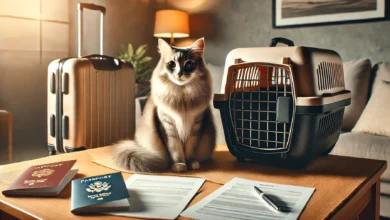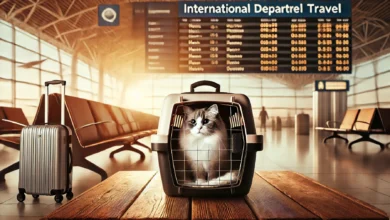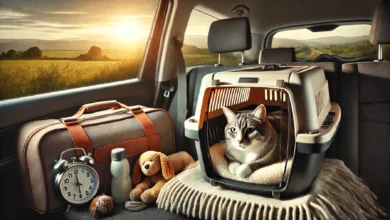Understanding Customs Regulations for Cats
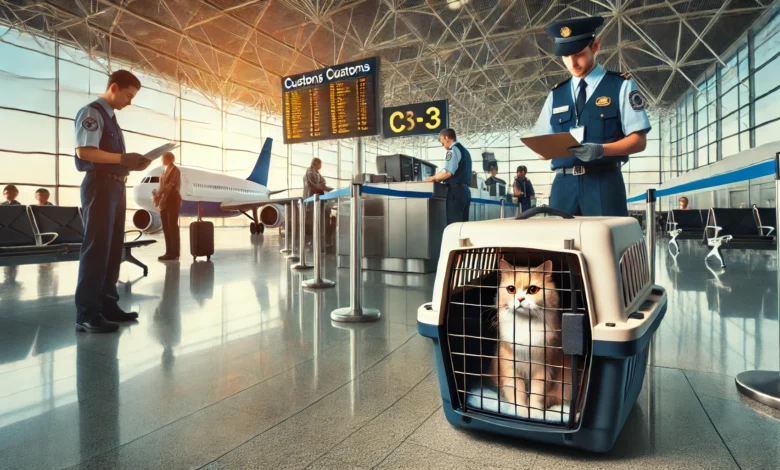
Traveling with your cat can be quite an adventure, but wading through customs regulations may feel overwhelming at times.
Whether you are relocating to a new country or going on vacation, having a clear understanding of the customs regulations for bringing cats across borders is essential.
Every country has its own set of customs regulations for pets, and being aware of what is needed in advance can save you a lot of stress.
In this article, we will describe the major steps in preparing your cat for international travel, including necessary documentation, vaccinations, and what to expect at customs checkpoints.
By the end, you will feel more confident traveling with your cat, knowing you’re fully prepared for the customs process.
Table of Contents
Introduction to Customs Regulations for Traveling with Cats
If you’re planning to travel with your cat, understanding customs regulations is one of the most important considerations.
These are the rules and protocols set by different countries to control what crosses in and out of their borders, including animals.
For cat owners, this means following specific laws designed to protect the local environment, wildlife, and domestic animals.
These regulations are aimed at preventing disease outbreaks and ensuring that animals crossing borders are healthy.
Most countries require vaccinations, health certificates, and identification for pets, all of which must be presented at customs checkpoints.
Failure to comply with these customs regulations could result in your cat being quarantined, sent back to the country of origin, or even denied entry altogether.
It’s crucial to research the customs regulations for both your departure and destination countries.
You may also need to consider the rules for any countries where you have layovers, as some have strict regulations for pets, even if you’re just passing through.
These customs rules can vary greatly from one country to another, so researching well in advance is key.
Many countries have additional customs regulations based on the breed of your cat, its age, or its medical condition.
You’ll want to ensure your cat’s health and vaccination records are up to date and meet the customs requirements of the destination country.
Over-preparing is always better than facing issues at the border.
Understanding and following customs regulations for cats is an essential part of the travel process.
By adhering to these rules, you can ensure a smooth and safe trip for both you and your cat, without unnecessary delays or complications at the customs checkpoints.
It’s important to research customs regulations well before you travel, as these rules vary significantly by country. Failure to meet these regulations could result in your cat being denied entry or placed in quarantine.

Preparing Your Cat for International Travel
Before embarking on an international journey with your cat, thorough preparation is very important for the smooth clearing of customs regulations.
Some countries have their own unique customs regulations, and preparing your cat in advance will help avoid unexpected problems.
Here, we will outline the basic steps to ready your cat for international travel, including documentation, vaccinations, and identification.
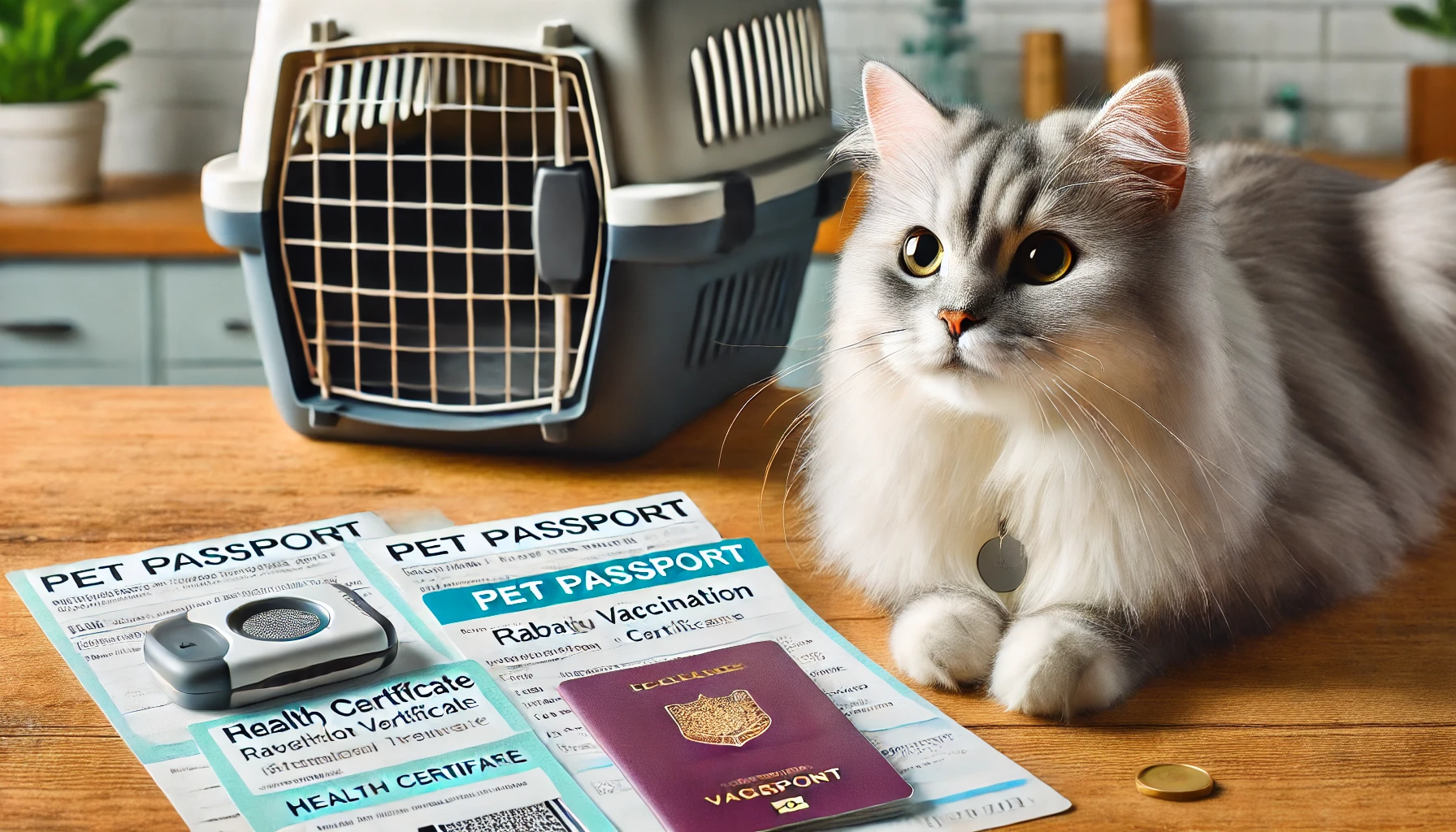
Cat Travel Documentation
The most important part of preparing your cat for travel is making sure you have the correct documentation.
Even pets need paperwork to cross international borders according to customs regulations.
This generally includes:
- Pet Passport or Veterinary Certificate: This is usually issued by a veterinarian, showing proof of your cat’s vaccinations and health. Most countries require this document to ensure that your cat is healthy and not contagious.
- Rabies Vaccination Certificate: Rabies vaccination is one of the most important requirements when traveling with pets. Most countries require it to be administered at least 21 days before travel.
- Health Certificate: This certificate is issued by a licensed veterinarian and states that your cat is healthy and fit for travel. Some countries require this document to be issued within a certain timeframe before departure, often within 10 days.
- Import Permit: Certain countries require an import permit for pets, which you must apply for in advance. Make sure to check if your destination country has this requirement.
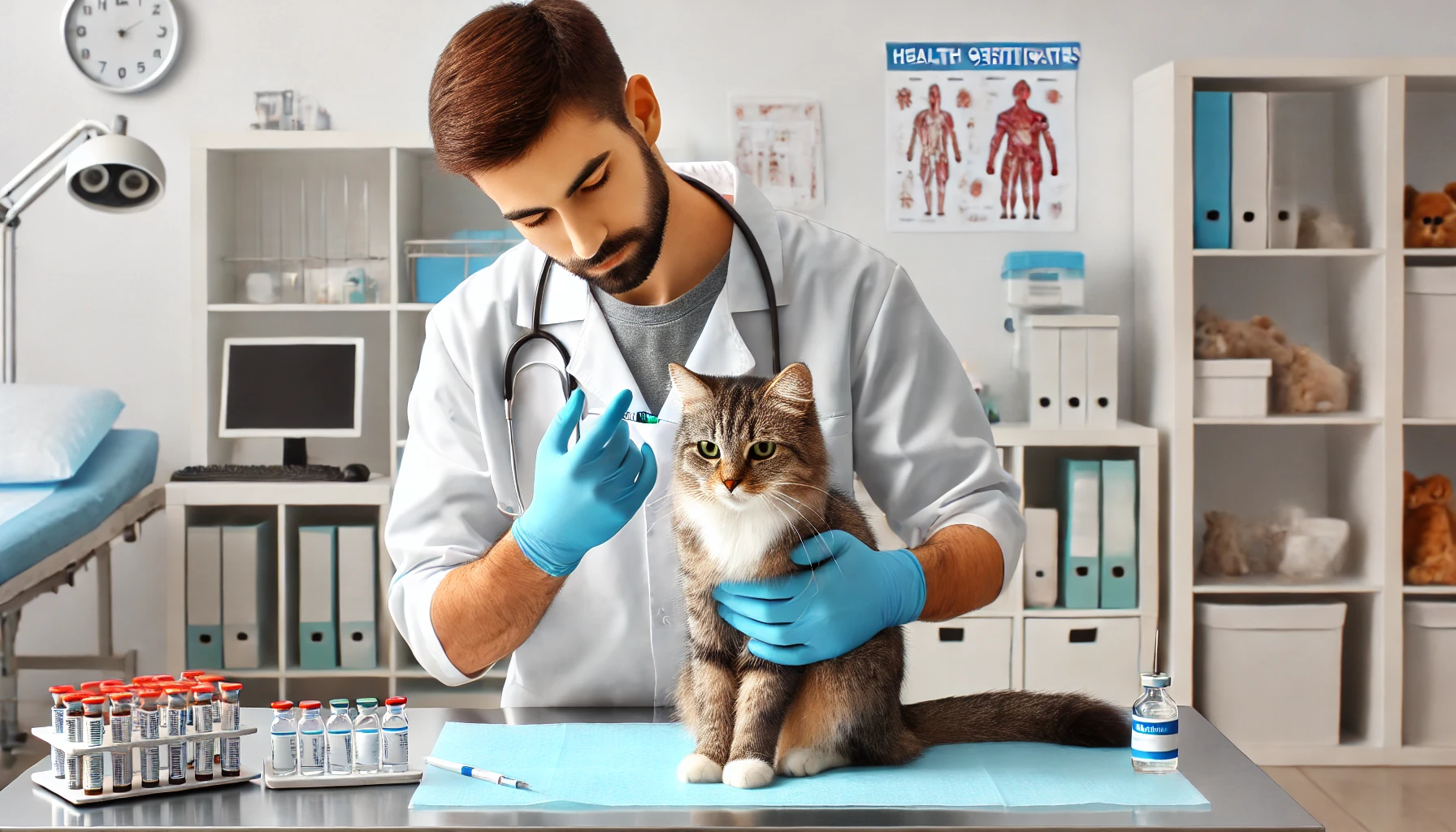
Vaccination and Health Requirements
Vaccination requirements for traveling abroad with your cat, along with health checks, vary greatly.
The most common requirement is a current rabies vaccination, but other vaccinations may also be required depending on your destination.
It is always best to consult with your veterinarian well in advance of your trip to ensure your cat meets all necessary customs regulations.
Some countries may also require additional vaccinations for illnesses like feline distemper or feline leukemia.
Your veterinarian can help you determine which vaccinations are needed for the countries you plan to visit.
It’s also important to ensure your cat is in good general health before traveling, as customs officials may deny entry to animals that appear sick or unfit for travel.
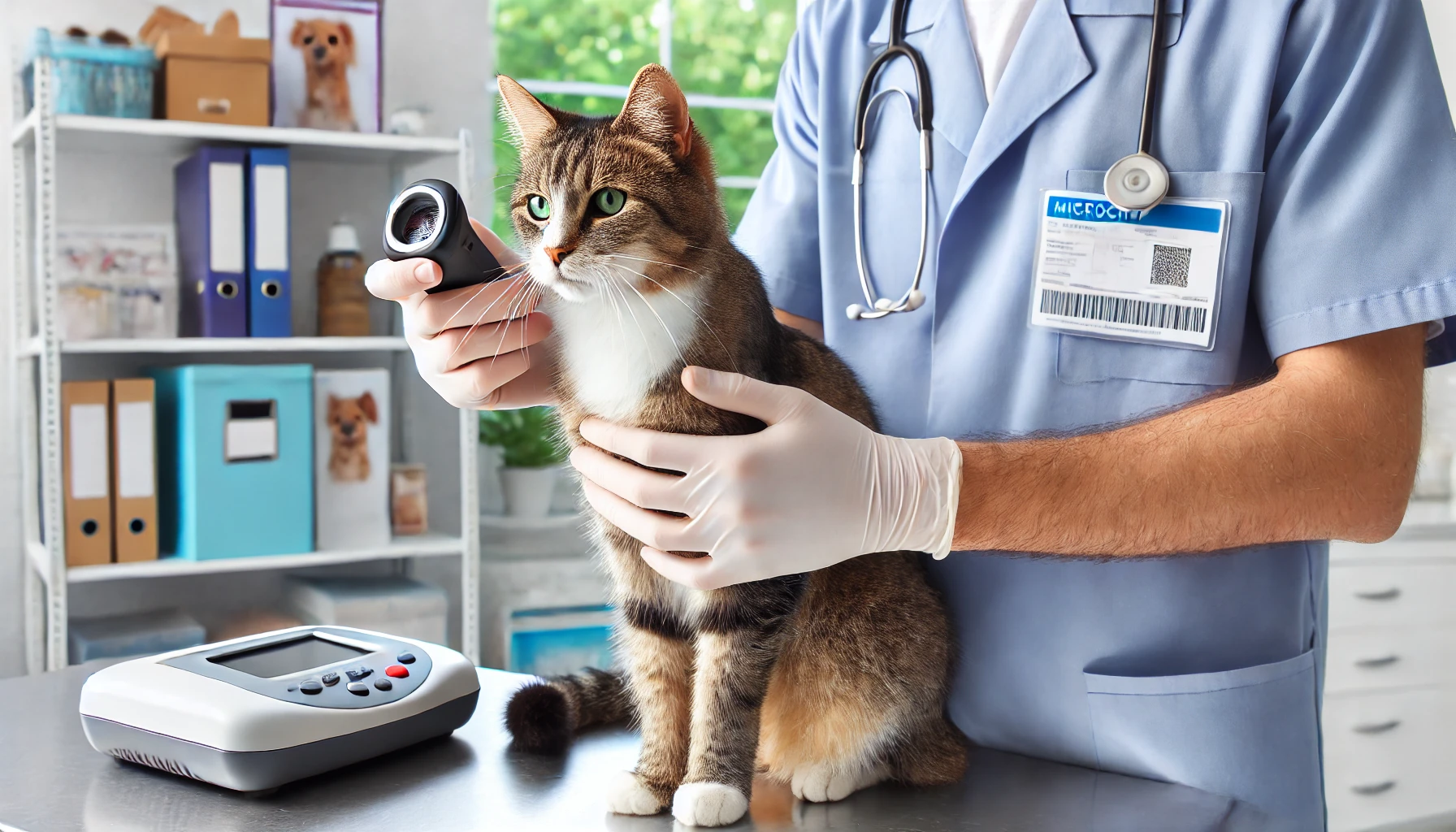
Microchip and Identification Guidelines
Most countries require a microchip for their customs regulations.
A microchip links your cat to its paperwork and provides a permanent form of identification in case your pet gets lost while traveling.
Make sure your cat’s microchip meets international standards, typically ISO 11784 or 11785, as some countries only accept specific types of microchips.
Additionally, placing identification information on an ID tag attached to your cat’s collar is advisable, alongside the microchip.
This can be helpful if your cat’s microchip cannot be read at customs or by local authorities.
By preparing these essential documents and ensuring your cat meets vaccination and identification requirements, you can avoid complications during customs entry.
These steps not only ensure legal travel but also help protect the health and safety of your cat while abroad.
Proper preparation, including having the right documentation and ensuring your cat is healthy, will make your international travel smoother and avoid issues at customs.
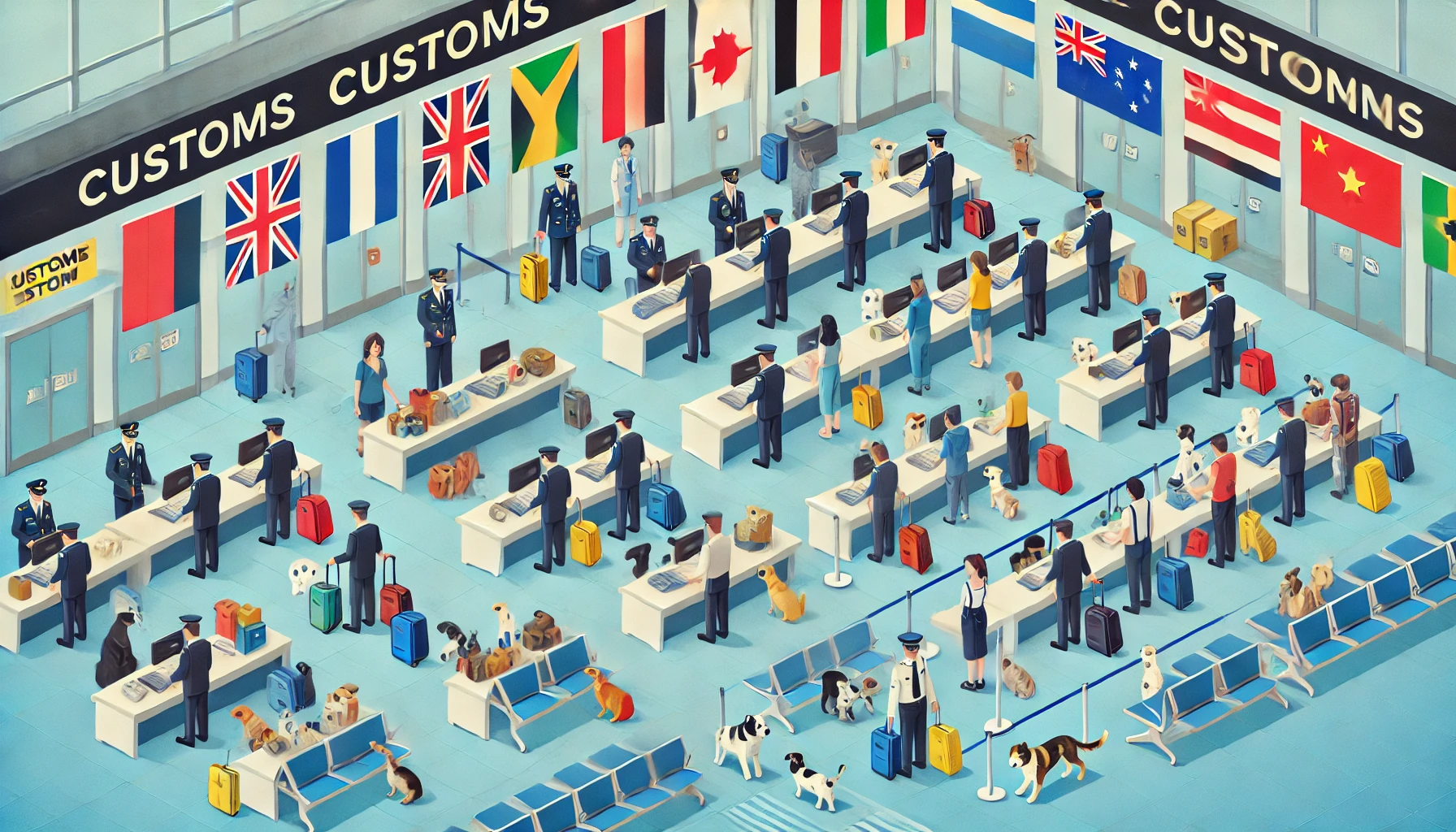
Understanding Country-Specific Customs Rules
Customs regulations regarding cats vary significantly depending on the destination country, and it is crucial to understand these differences.
Each country has its own rules regarding the importation of pets, and failure to meet these customs regulations can result in your cat being quarantined, denied entry, or even returned to its country of origin.
The following sections outline customs regulations for different regions you need to be aware of when traveling with your cat.
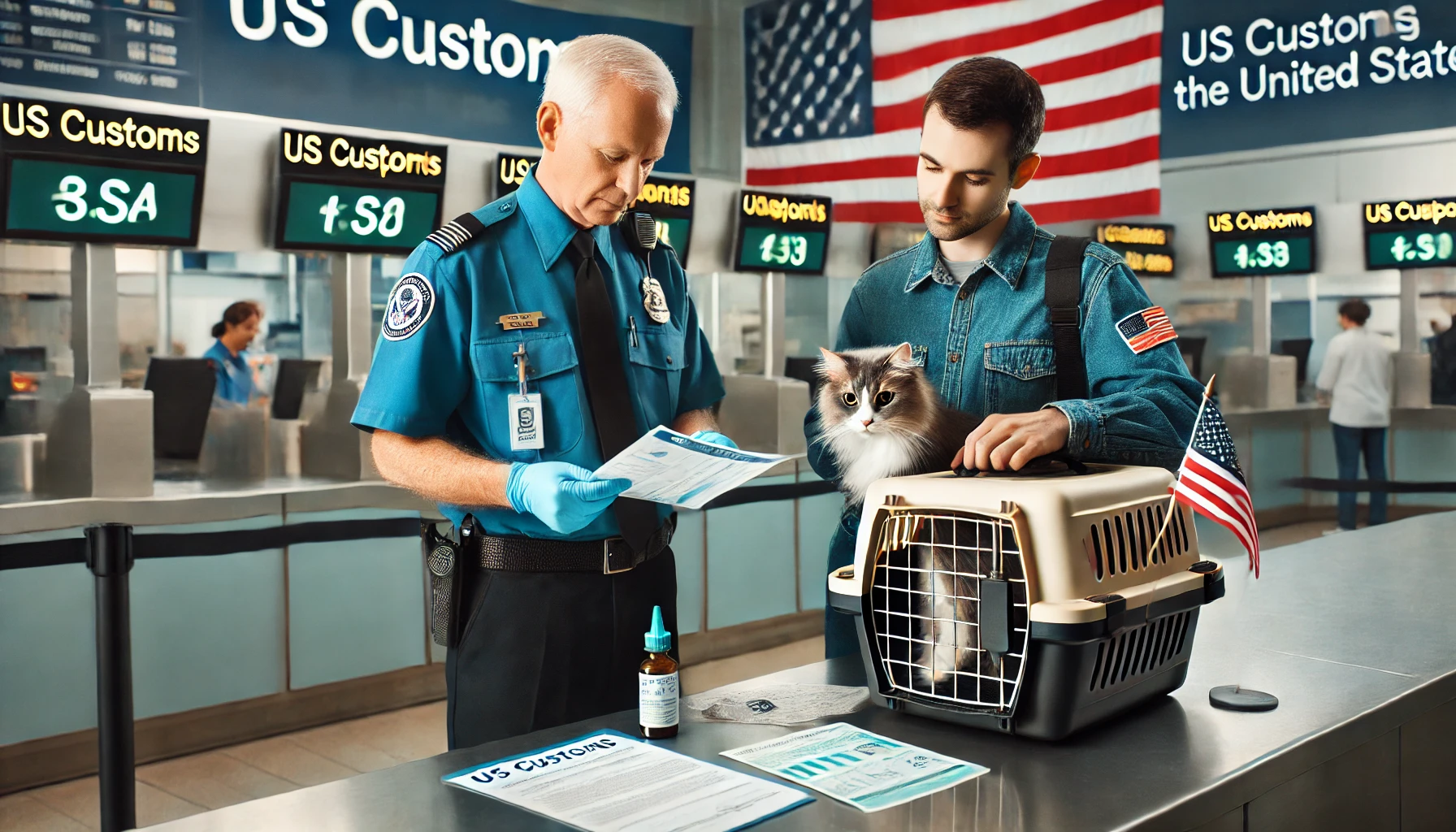
US Customs Regulations
The United States has relatively straightforward customs regulations when it comes to cats.
There is no quarantine requirement for cats, but proof of a valid rabies vaccination is necessary.
If your cat is coming from a country recognized as rabies-free, the rabies vaccination is not required.
However, cats that appear ill may be subject to further inspection and possibly quarantined.
The Centers for Disease Control and Prevention (CDC) also require a health certificate from a licensed veterinarian attesting to your cat’s fitness to travel.
This document must be prepared prior to arrival.
While microchipping is not required in the U.S., it is highly recommended for identification purposes.
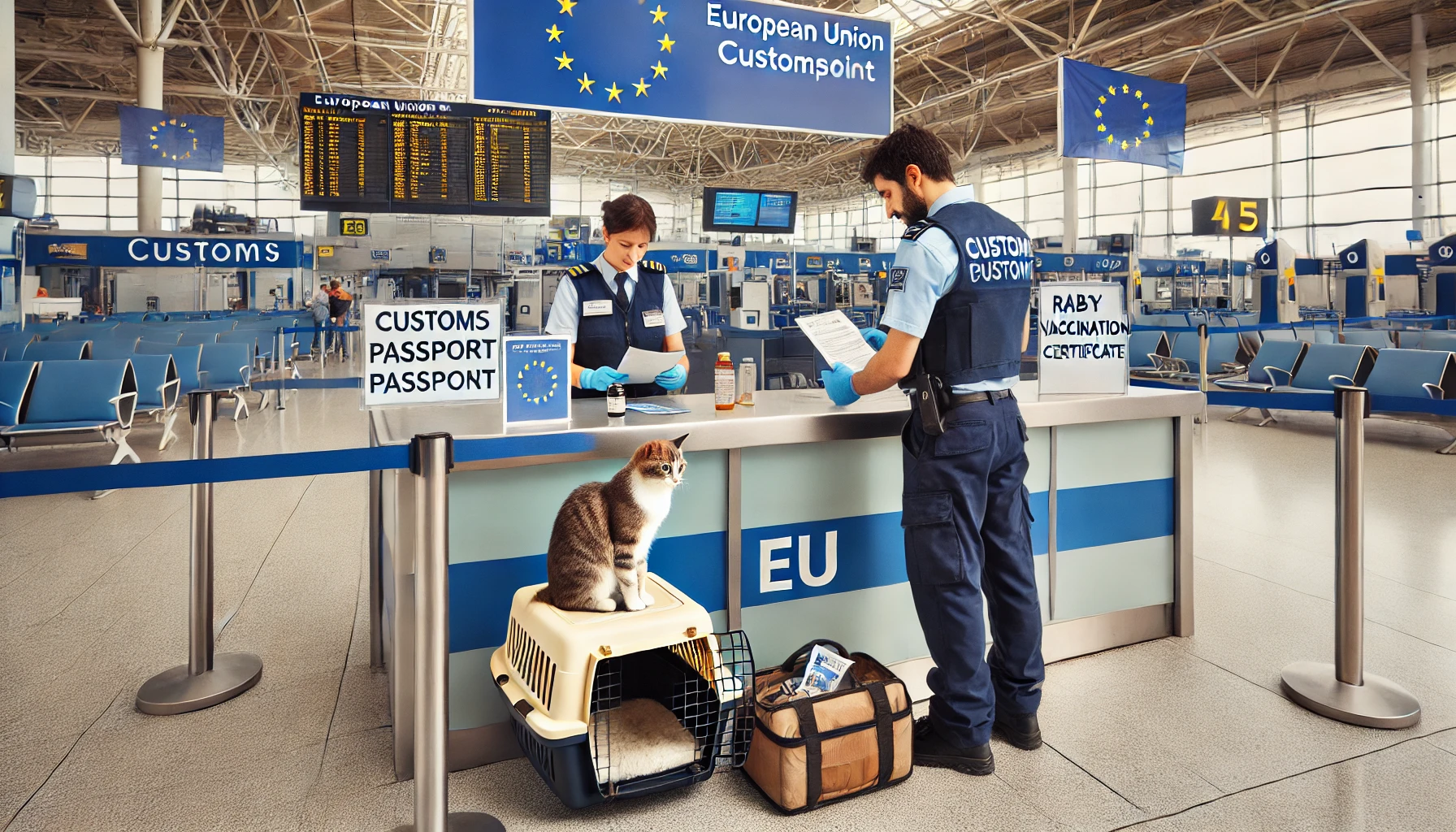
Customs Rules in the European Union
Traveling within the European Union (EU) has been made easier with standardized customs regulations for cats.
Your cat must be microchipped, have a valid rabies vaccination, and be accompanied by either a pet passport or an equivalent veterinary certificate to enter the EU.
The rabies vaccination must have been administered at least 21 days prior to travel.
Some EU countries, such as Finland, Ireland, and Malta, have special tapeworm treatment requirements.
Be sure to check the regulations of your destination country to stay in compliance.
The EU Pet Passport simplifies travel across borders in Europe, so keeping this document updated is essential.
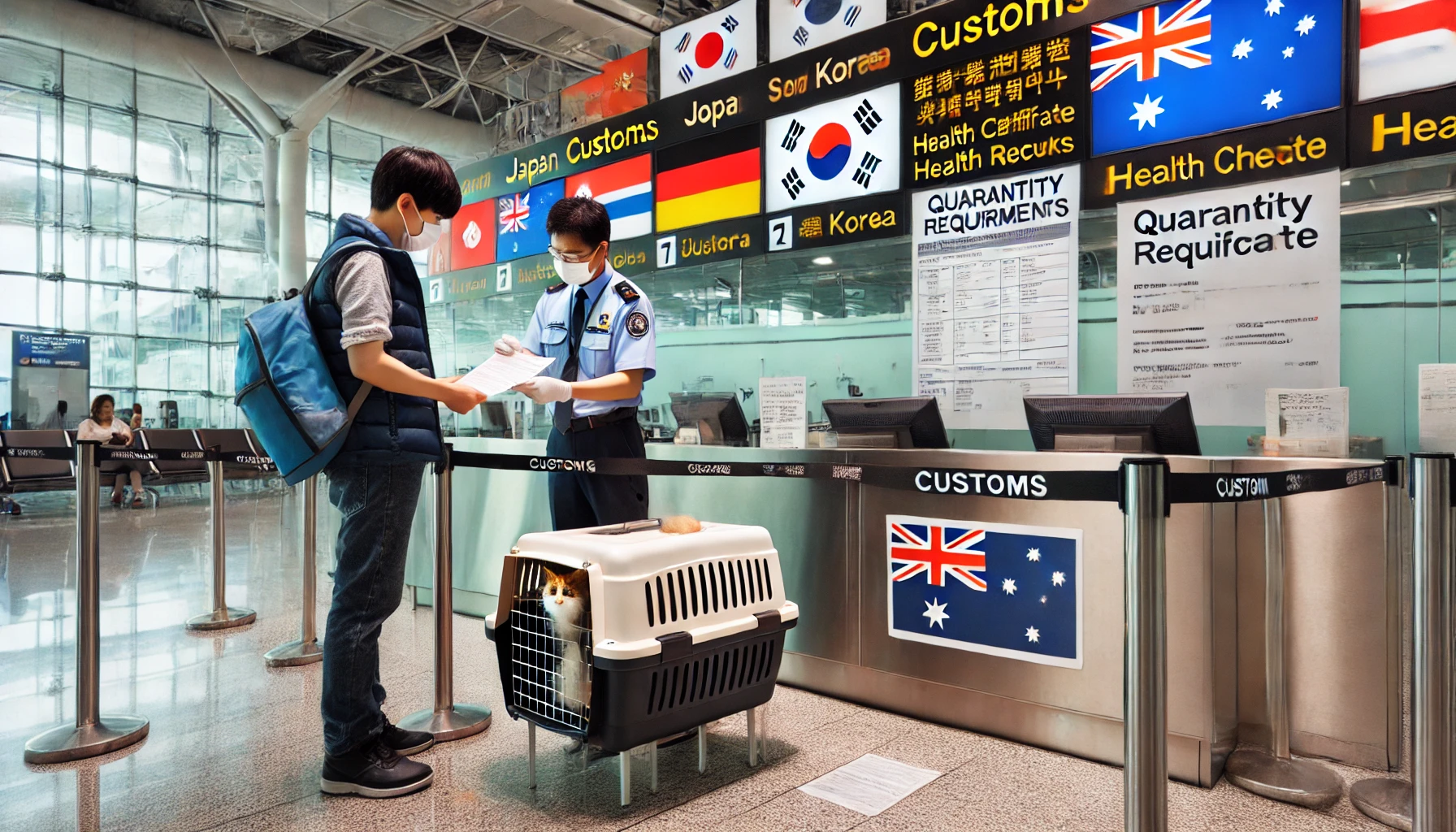
Pet Travel Policies in Asia and Australia
In Asia and Australia, customs regulations tend to be more stringent.
For example, Australia enforces a strict quarantine policy to prevent the introduction of diseases like rabies.
Cats traveling to Australia must be quarantined for a minimum of 10 days upon arrival and undergo multiple health checks and vaccinations, including rabies, before entry is granted.
In countries like Japan, South Korea, and Singapore, the quarantine period may vary depending on the country of origin.
Cats must be microchipped, have up-to-date vaccinations, and carry a health certificate.
Some countries also require advance notification of your cat’s arrival, so it’s essential to plan well in advance.
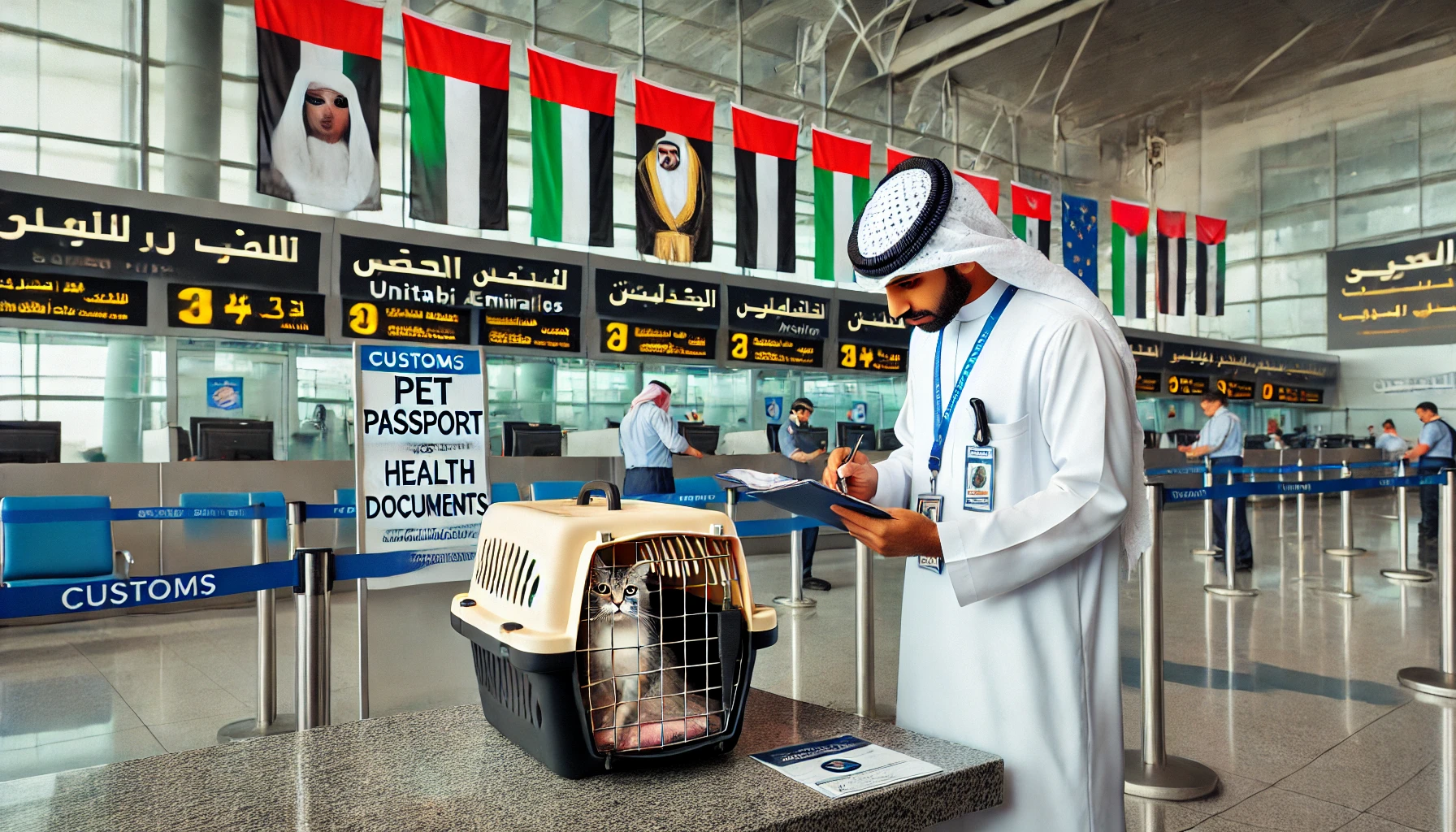
Middle Eastern Countries Regulations
Middle Eastern countries, including the United Arab Emirates (UAE) and Saudi Arabia, have specific customs regulations for pets.
In the UAE, your cat must be microchipped, vaccinated against rabies, and accompanied by a health certificate issued by a licensed veterinarian.
Some Middle Eastern countries may also have restrictions on certain cat breeds, so it is advisable to check with local authorities in advance.
By being informed about the customs regulations of your destination country and making the necessary preparations, you can ensure a smooth and hassle-free entry for your cat.
Researching these regulations well in advance is the best way to avoid potential delays or complications at the border.
Each country has specific rules regarding the import of pets, and it’s essential to be aware of the specific customs regulations for your destination and any countries you transit through.
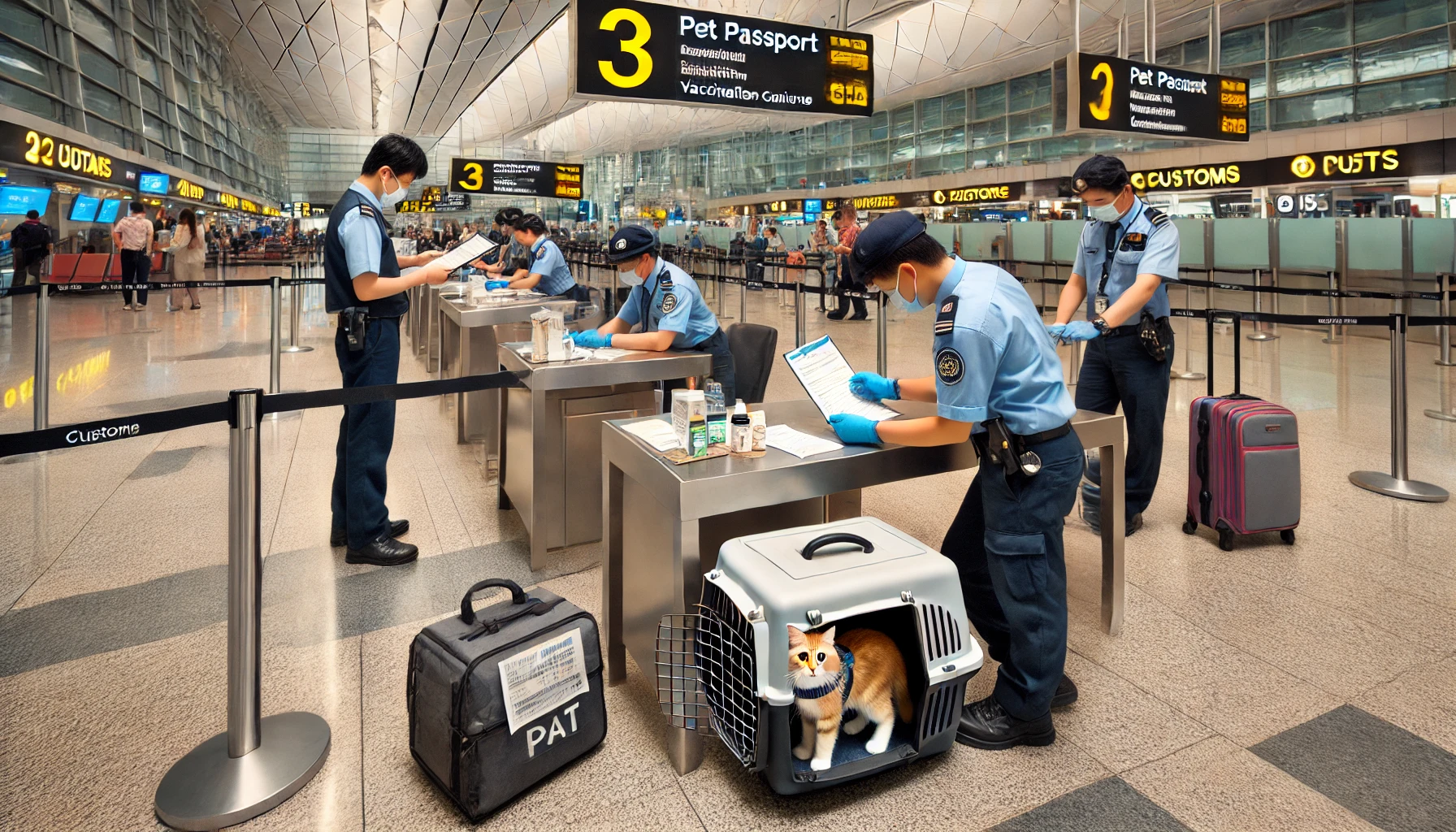
Clearing Customs: What to Expect at the Border
Clearing customs can be one of the more stressful aspects of traveling with your cat across international borders.
Understanding what to expect at the border can greatly reduce anxiety and make the process smoother.
In this section, we will cover the typical procedures for clearing customs with your cat, common issues to watch for, and how to avoid delays or complications.
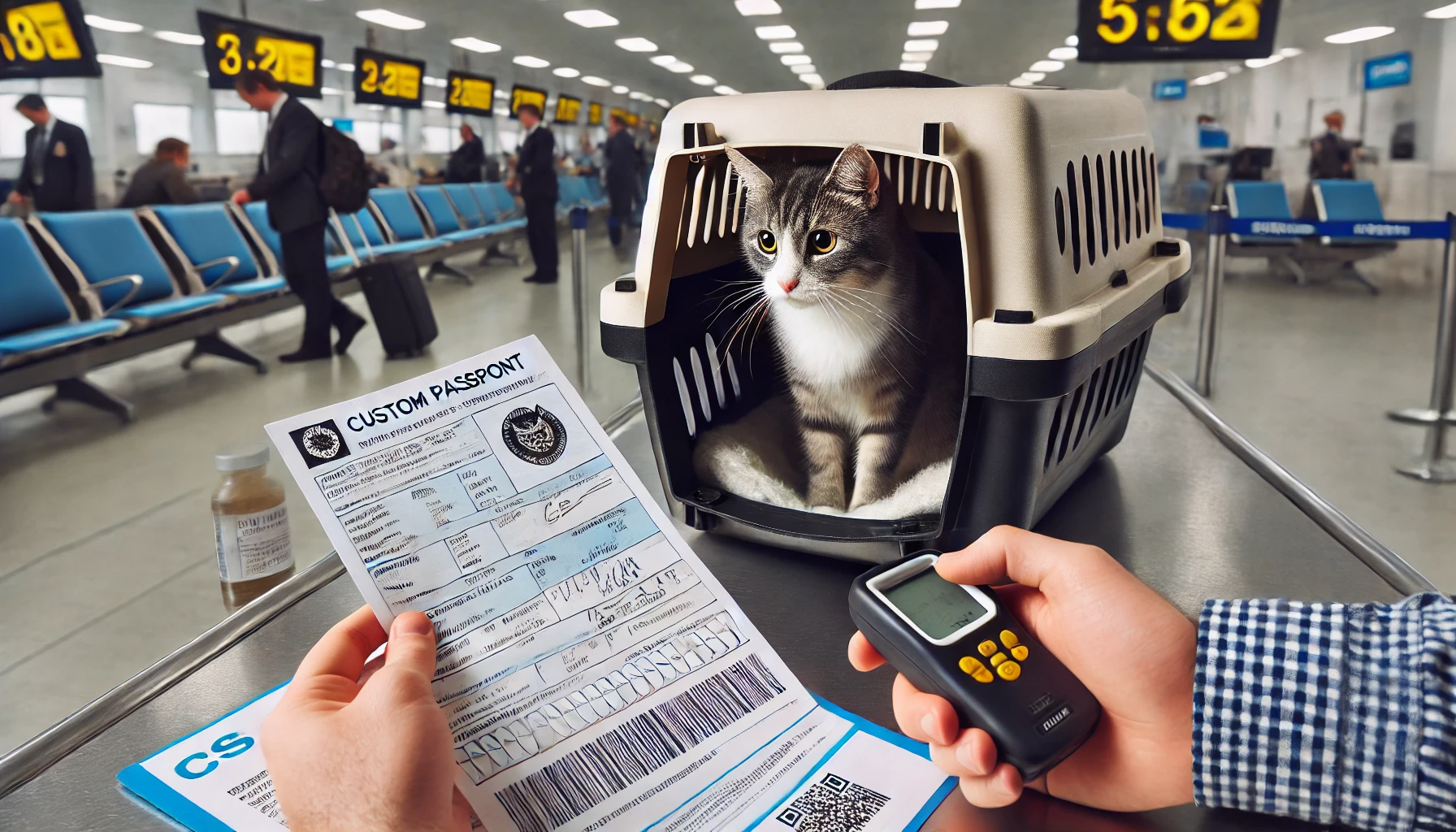
The Customs Process for Cats
The customs process for your cat, like any other pet, is generally broken into several key steps that you need to prepare for:
- Checking of Documents: Upon arrival at the border, the first step is usually a check of your cat’s documents. This involves verifying your cat’s pet passport or veterinary certificate, rabies vaccination, health certificate, and import permits if applicable. Having all your documents readily available and organized can make this process smoother.
- Health Inspection: Some countries may require a physical inspection of your cat to confirm that it appears healthy and fit for entry. If your cat looks ill or shows signs of stress, customs officials may request further health checks, which could lead to quarantine.
- Microchip Scanning: In countries that require microchips, customs officials will scan your cat to verify that the microchip matches the documentation provided. Be sure to check that your cat’s microchip is ISO-compliant and functioning properly before traveling.
- Quarantine Check: In countries with quarantine requirements, your cat may be taken directly to a quarantine facility after clearing customs. The duration and conditions of quarantine depend on the destination country’s laws and your cat’s country of origin.
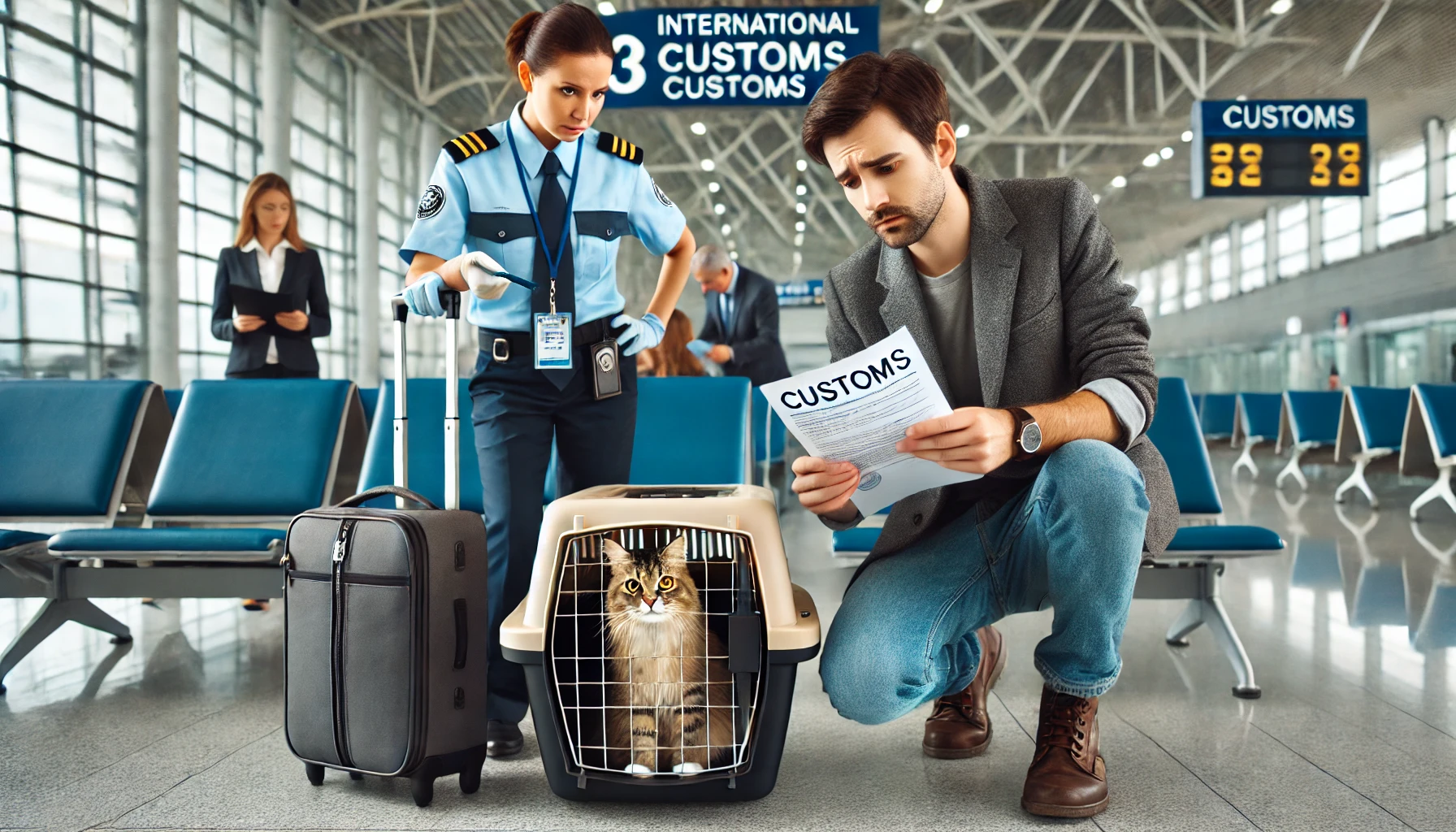
Common Pitfalls and How to Avoid Them
Even with thorough preparation, common issues can arise during the customs process.
Being aware of these potential pitfalls can help you avoid them:
- Missing or Incomplete Documentation: Ensure all required documents are current, accurate, and accessible. Double-check the requirements for your destination country and any countries you are transiting through.
- Expired Vaccinations: Ensure that your cat’s vaccinations, especially rabies, are up to date. Some countries have specific time frames within which vaccinations must be administered before travel, so plan ahead.
- Incorrect Microchip: Customs officials may impose fines or deny entry if your cat’s microchip is not ISO-compliant or unreadable. Check that your cat’s microchip is functioning properly before your trip.
- Health Problems: If your cat appears sick or overly stressed at the border, customs officials may request additional health checks, leading to delays or quarantine. Ensure your cat is well-rested, calm, and healthy before traveling.
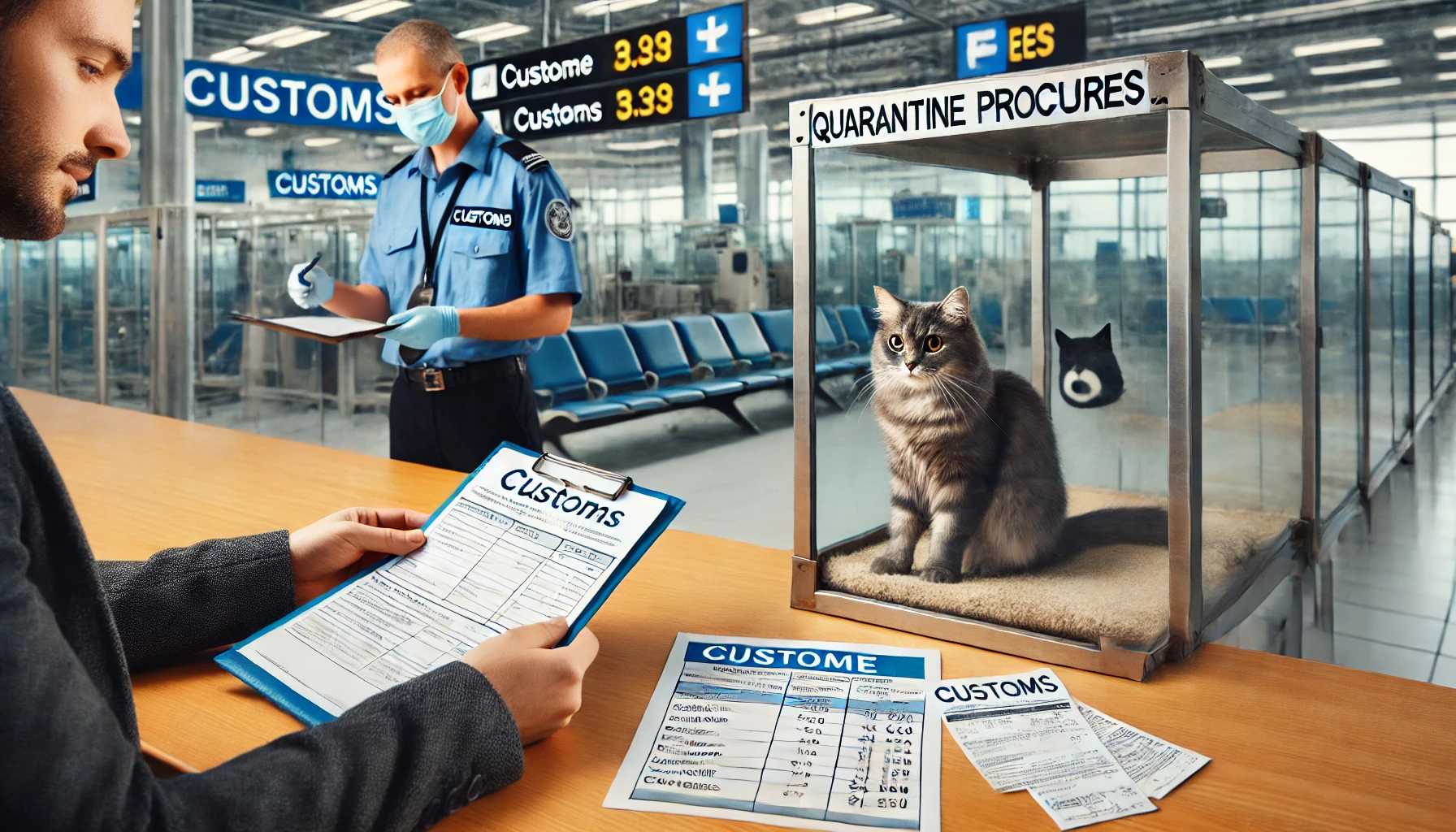
Customs Fees and Quarantine Policies
Most countries charge customs fees for importing pets, which can vary depending on the country and whether quarantine is required.
These fees may include inspection charges, import permits, and quarantine facility costs.
Be sure to budget for these expenses in advance.
If your destination country requires quarantine, familiarize yourself with the process.
Quarantine periods can range from a few days to several weeks, depending on the country.
Some countries allow home quarantine, while others require pets to stay in designated quarantine facilities.
Be prepared for your cat’s stay, including any necessary supplies and additional documentation.
Understanding the customs process, ensuring your cat’s documents are in order, and being prepared for any potential issues can help you clear customs smoothly and ensure a hassle-free journey for both you and your cat.
Having organized documentation, ensuring your cat’s vaccinations are up to date, and understanding customs procedures will help you clear customs smoothly without delays.
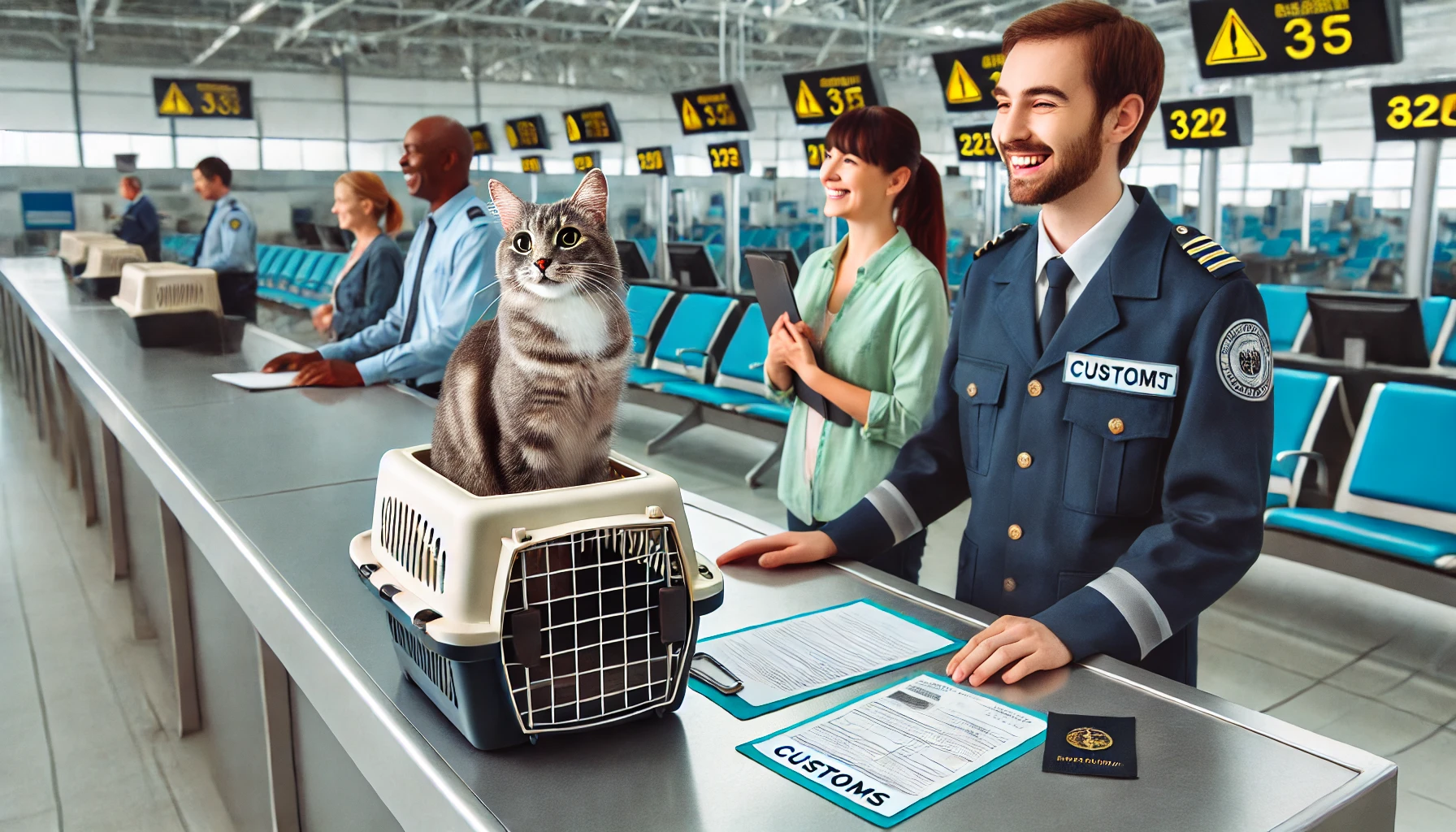
Tips for a Smooth Customs Experience with Your Cat
Traveling with your cat can be a nervous affair for both you and your pet, but with proper preparation, this stress can be minimized.
In this section, we will guide you through practical tips that will help you navigate customs efficiently, calm your cat, and avoid unnecessary hassles.
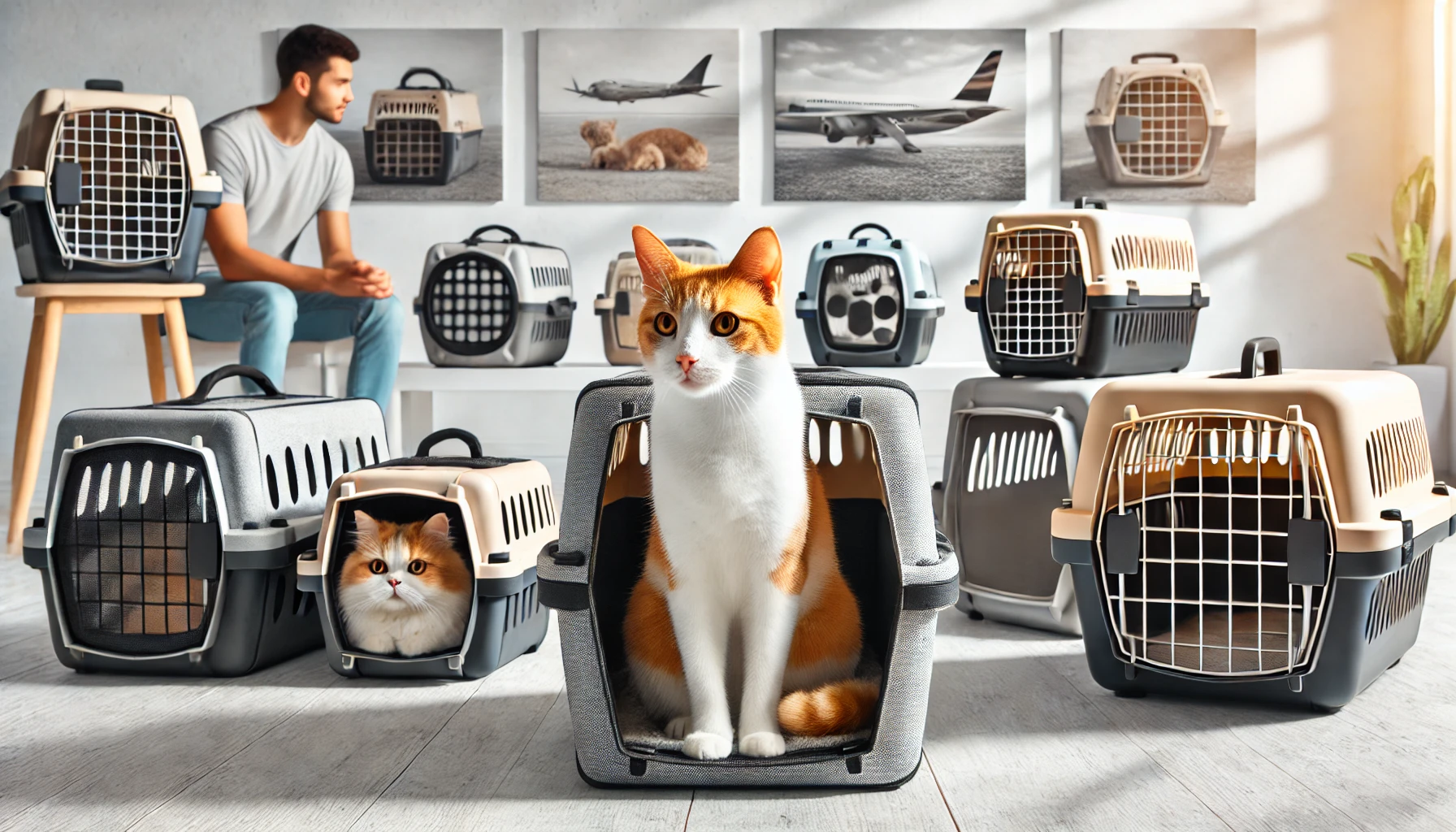
Choosing the Right Pet Carrier
Choosing the right pet carrier is one of the most important factors in ensuring a stress-free journey for your cat.
When selecting a carrier, ensure that it meets airline and customs regulations, as each country may have its own guidelines regarding the size, type, and ventilation of pet carriers.
The carrier should be large enough to allow comfortable movement for your cat and well-ventilated to keep them cool and calm.
Look for airline-approved carriers, which meet the necessary requirements.
Consider soft-sided carriers for flexibility in tighter spaces, while hard-sided carriers offer more protection.
Additionally, a secure locking mechanism can prevent your cat from escaping during travel.
Allow your cat to get used to the carrier well before your trip.
Place familiar bedding or toys inside to create a comforting environment.
This will help reduce anxiety when it’s time to travel.
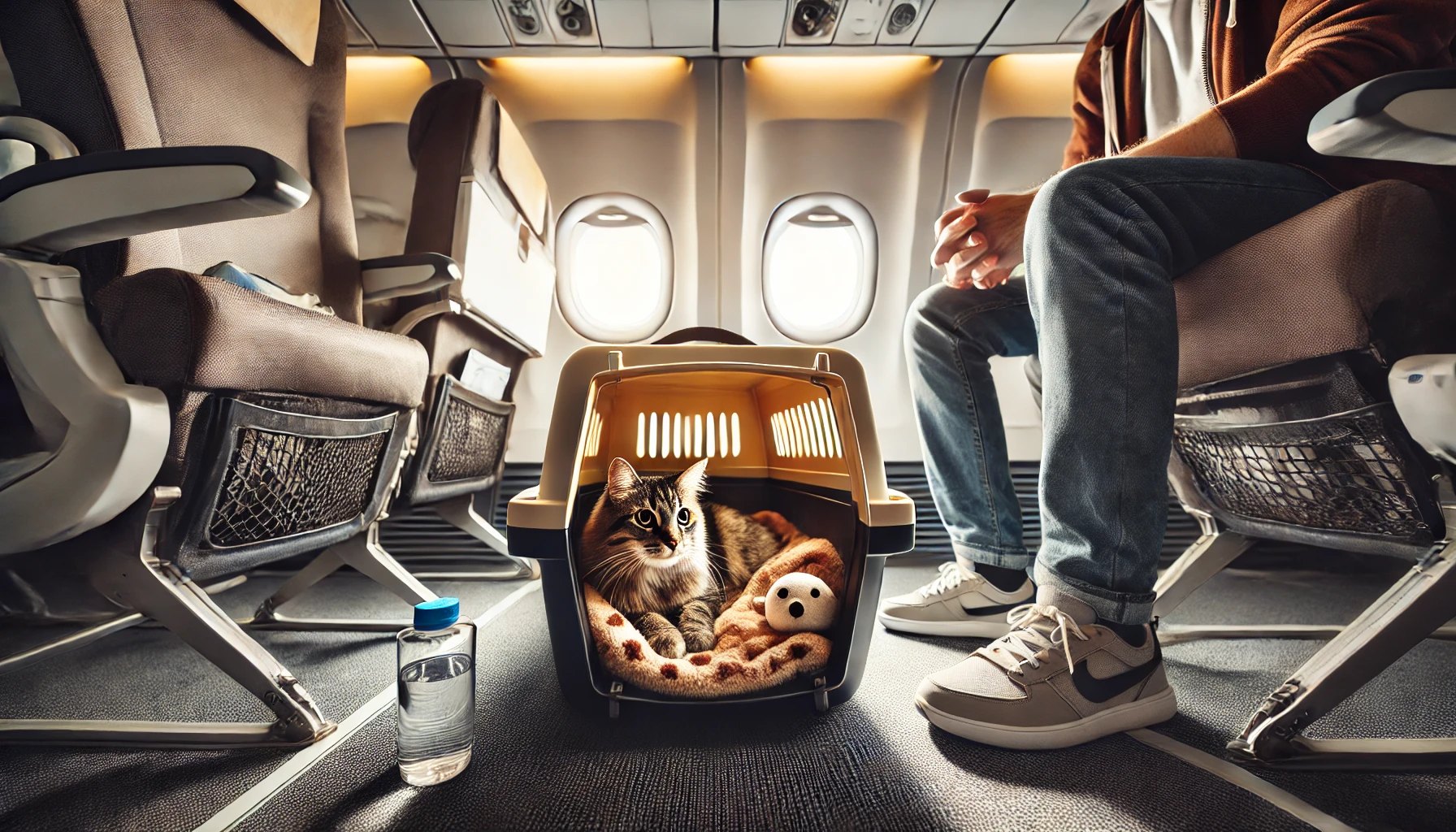
Minimizing Your Cat’s Stress While Traveling
Travel can be intimidating for cats, but you can take several steps to reduce the stress:
- Use Calming Aids: Pheromone sprays, calming collars, or over-the-counter supplements designed to reduce stress in cats can be helpful. These can be applied to the carrier or near your cat to keep them calm during the flight or car ride.
- Maintain a Calm Environment: Cats are sensitive to noise and movement, so aim for a quiet, stable environment during the journey. Avoid sudden loud noises or movements, as they may frighten your cat.
- Familiar Smells: Place items carrying your scent or your cat’s favorite blanket inside the carrier to provide a sense of security. Familiar smells help cats feel more comfortable in new surroundings.
- Limit Food Before Travel: Avoid giving your cat a large meal before the journey to reduce the risk of motion sickness. Offer a light meal a few hours before travel and ensure your cat stays hydrated.
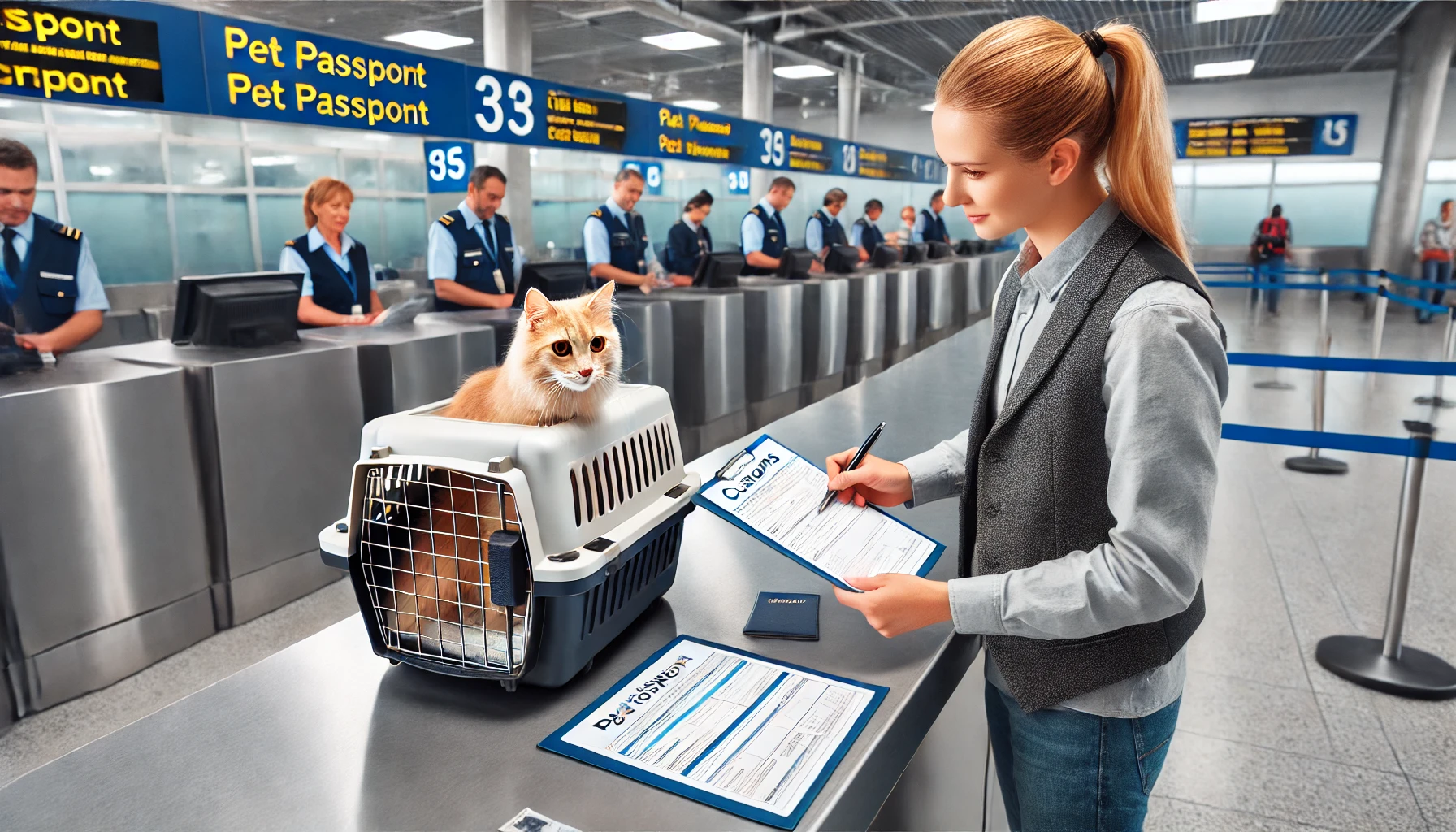
Clearing Customs Smoothly
Preparation is essential for an efficient customs clearance process.
Here’s how you can ensure a smooth experience:
- Organize Documents: Keep your cat’s paperwork, including the pet passport, veterinary certificates, and import permits, organized in one folder for easy access. Having your documents ready will help expedite the customs process.
- Plan for Arrival: Familiarize yourself with the arrival procedures, especially if quarantine is required. Knowing the location of the quarantine facility and how long the process will take can prevent unnecessary delays.
- Prepare for Inspection: Be ready for a possible health check or microchip scan. Keep your cat calm during these procedures to avoid complications.
- Communicate with Officials: Customs officials may ask questions about your cat’s health or documentation. Be polite, cooperative, and ready to provide any additional information if requested.
By following these tips, you can ensure a smooth and hassle-free customs experience for both you and your cat.
With proper preparation, you’ll handle the process confidently and enjoy a safe journey with your feline companion.
By following these practical tips, such as choosing the right carrier and keeping your cat calm, you can ensure a stress-free customs experience for both you and your cat.
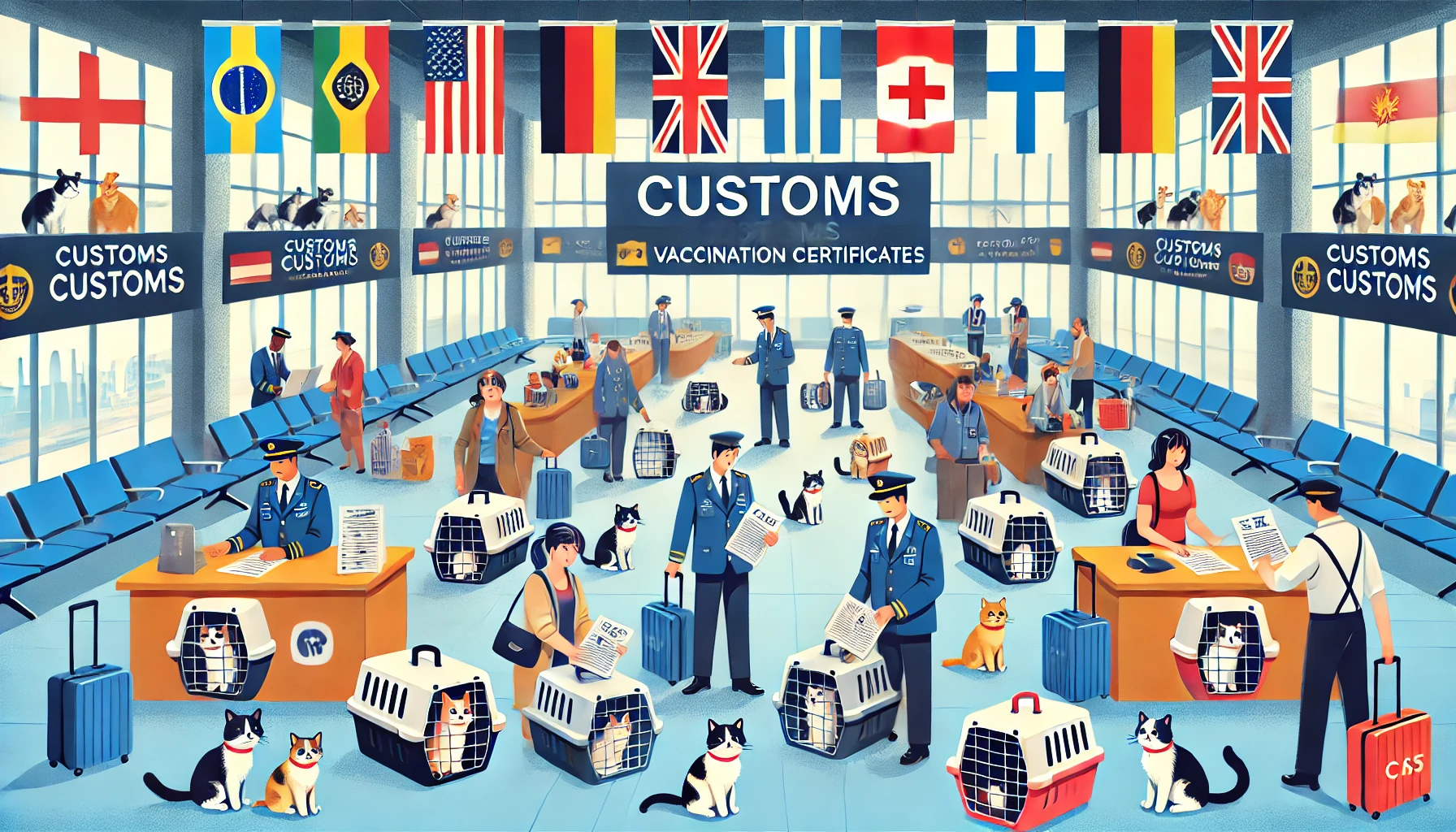
Overview of Major Customs Regulations When Traveling with Cats
International travel with a cat requires careful planning and attention to customs regulations.
Not every country shares the same rules regarding the importation of pets.
Knowing what to expect from these customs regulations well in advance can help avoid unnecessary stress for both you and your cat.
From choosing an appropriate carrier to preparing the required documentation, following the right steps ensures a stress-free travel experience for your feline companion.
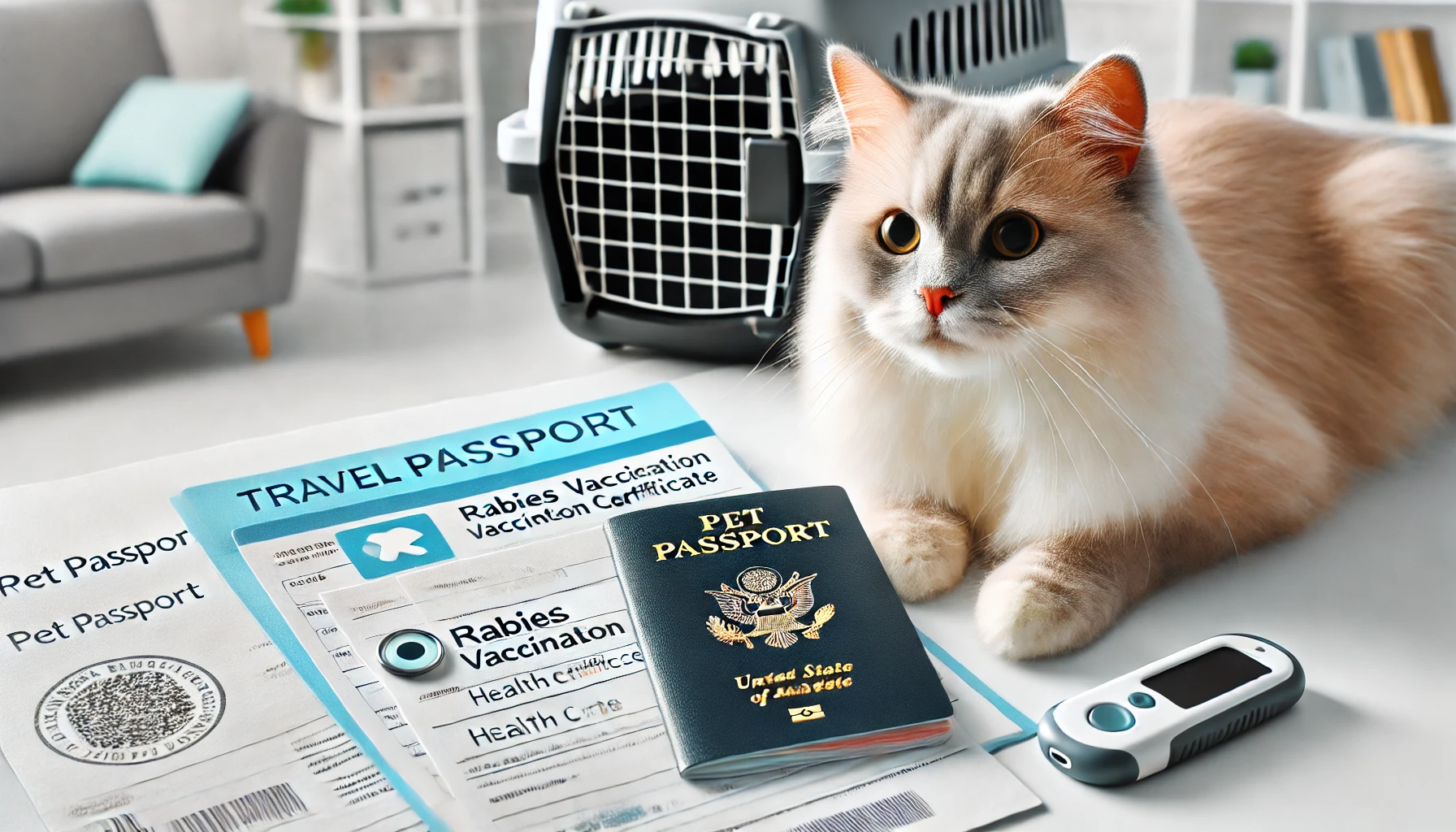
Understanding Documentation and Vaccination Requirements
The first and most crucial step in international travel with your cat is understanding the documentation and vaccination requirements of your destination country.
Customs regulations typically require the following:
- A valid pet passport or veterinary certificate as proof of your cat’s health and vaccination record.
- Up-to-date rabies vaccinations, which are required in most countries before allowing your cat to enter.
- Additional health certificates confirming that your cat is fit for travel, issued by a licensed veterinarian.
- Microchip identification for easy verification during customs checks, required by most countries.
Ensuring that your cat’s paperwork is complete, accurate, and compliant with the customs regulations of your destination country is essential for hassle-free entry.
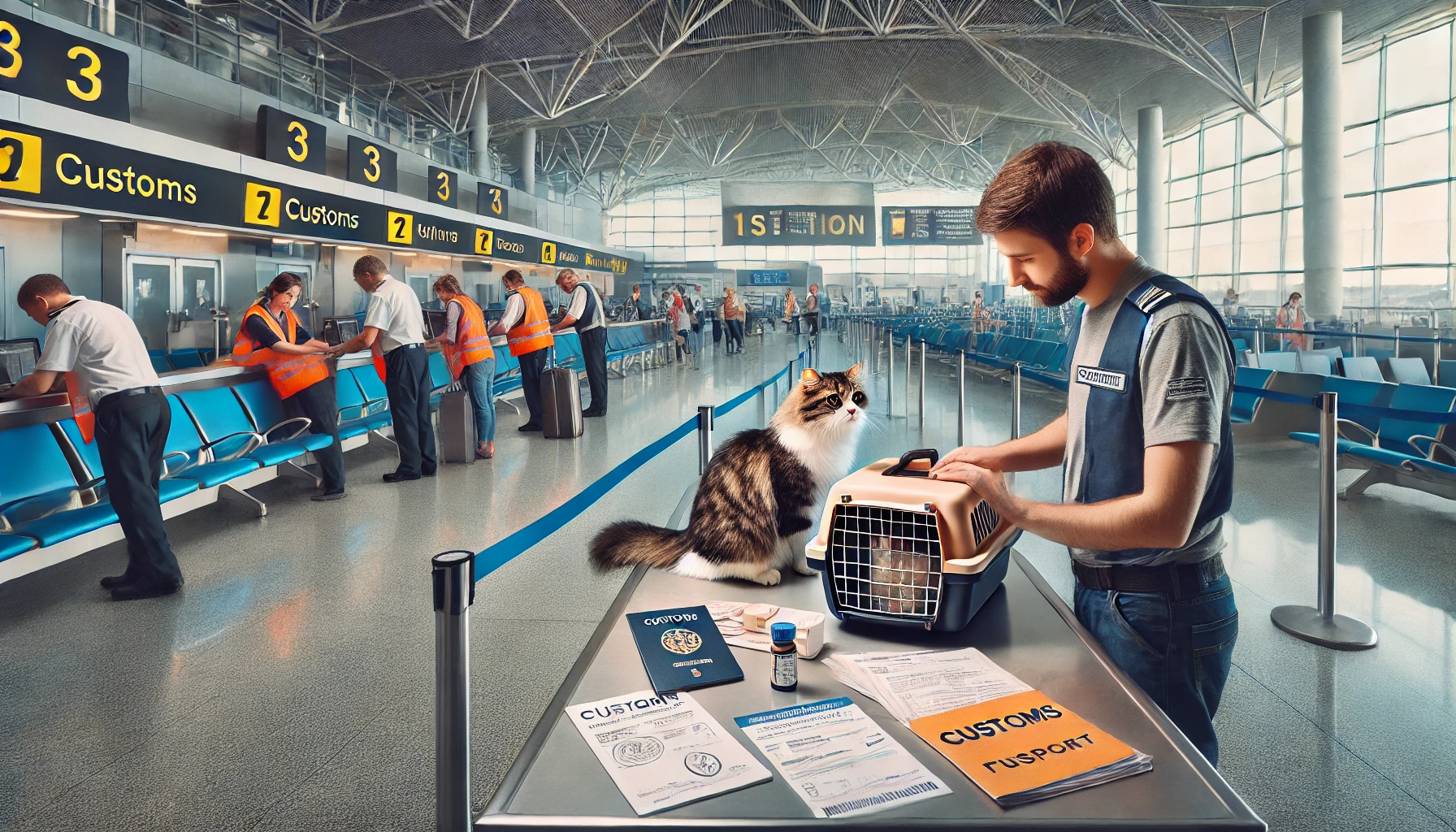
Preparing for Customs Inspections
Once you reach customs, your cat will undergo several checks, including document verification, health inspections, and sometimes even microchip scans.
By organizing your paperwork in advance and knowing how customs inspections work in the destination country (and any transit countries), you can save significant time at the border.
Understanding customs regulations beforehand can help you avoid last-minute complications or delays.
Some countries require quarantine for cats, particularly those with strict regulations like Australia or Japan.
If quarantine is necessary, being well-prepared by knowing the duration, fees, and procedures involved can make the process smoother.
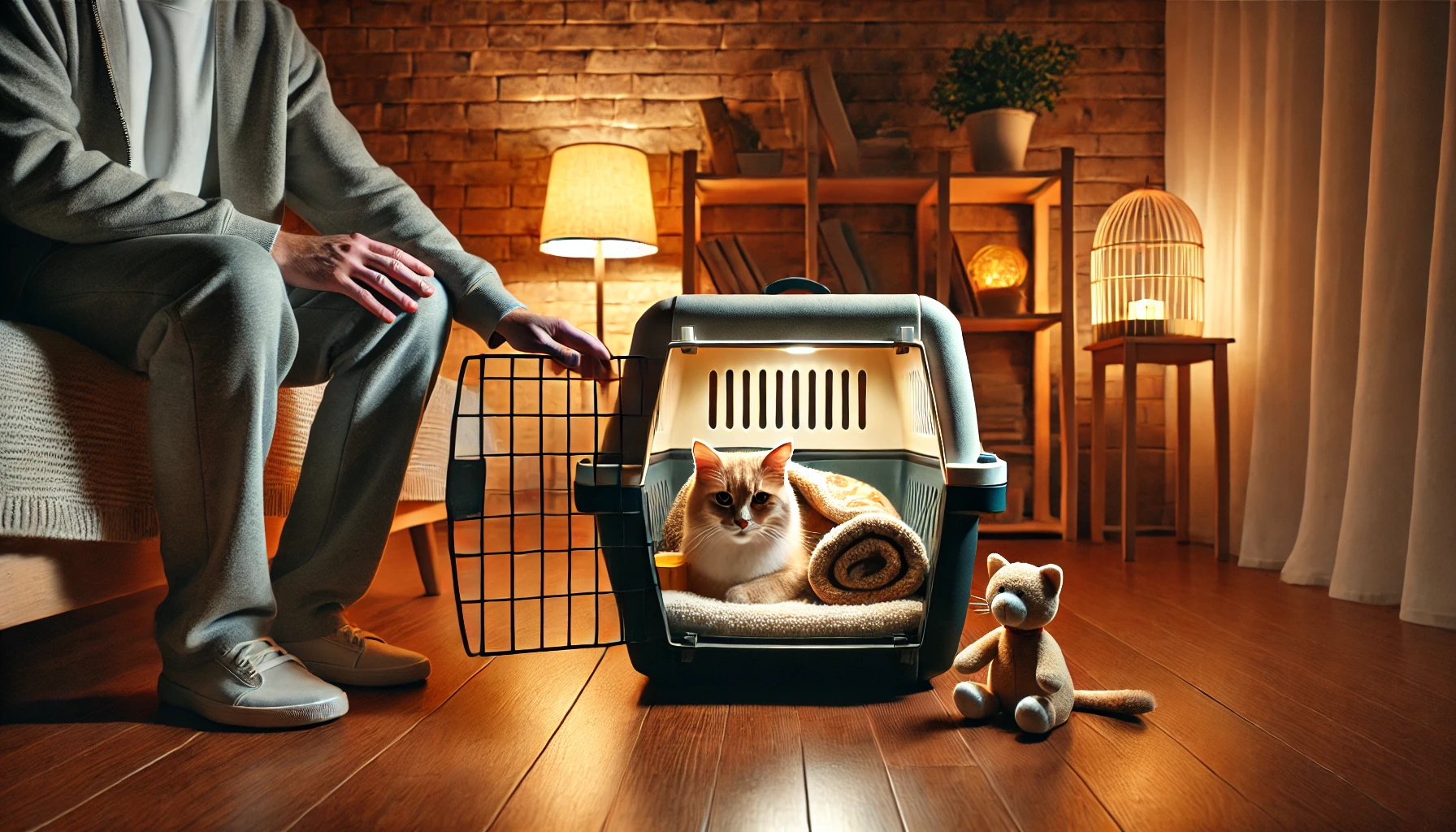
Reducing Your Cat’s Stress
Travel can be stressful for cats, but there are several things you can do to minimize their anxiety.
Selecting the right pet carrier and allowing your cat to get familiar with it ahead of time is a key step.
Ensure the carrier meets airline and customs regulations and provides enough comfort for your cat during long hours of travel.
You can also use calming aids like pheromone sprays or place familiar items with your cat’s scent inside the carrier.
Keeping your cat well-hydrated, lightly fed before travel, and maintaining a quiet, peaceful environment will help reduce stress during the journey.
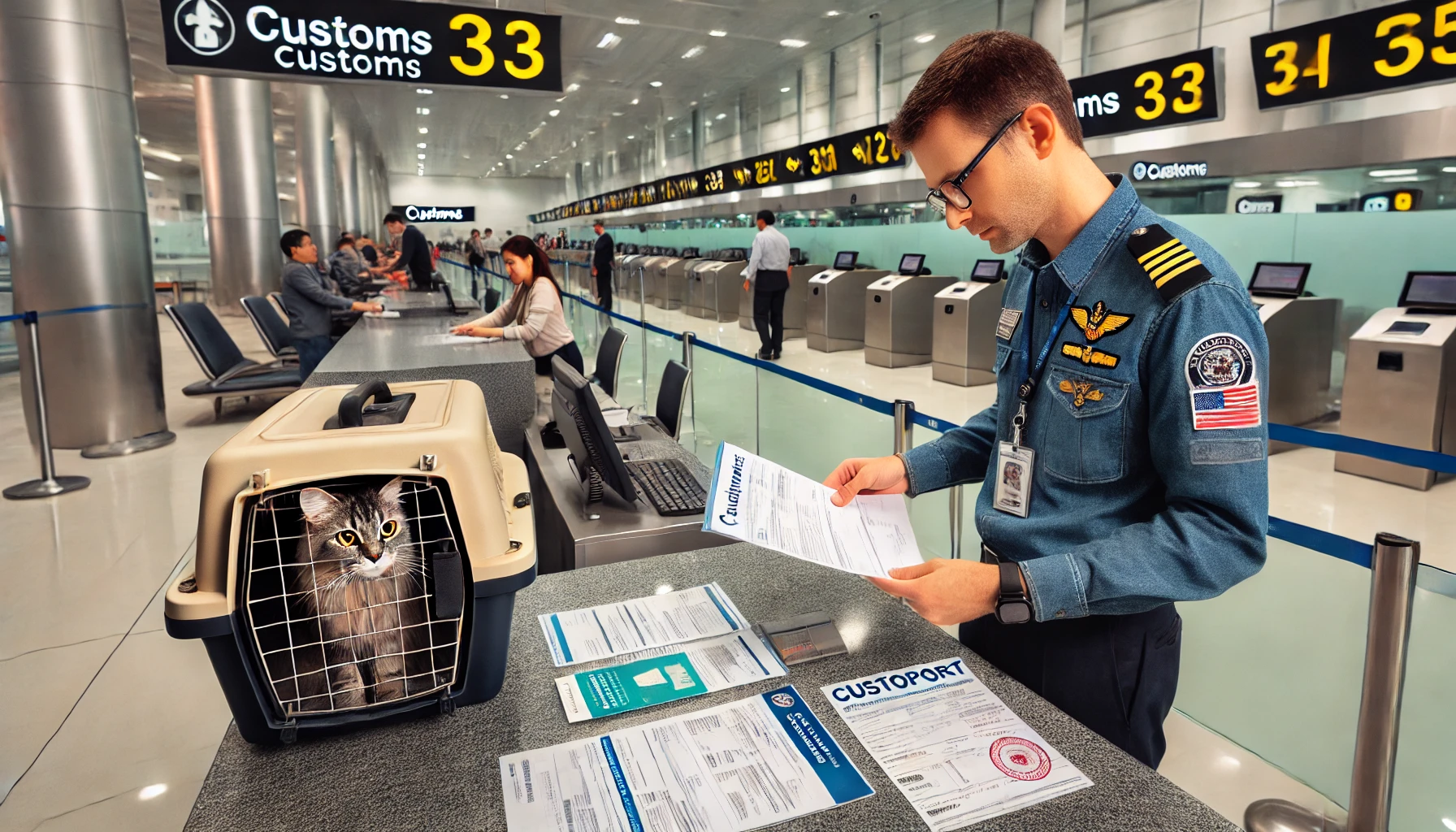
How to Clear Customs Efficiently
Customs clearance can seem daunting, but it doesn’t have to be if you are well-prepared.
Have all your cat’s documents—pet passport, veterinary certificates, and any required import permits—ready and easily accessible.
This preparation will expedite the customs process.
Be prepared to answer questions from customs officers regarding your cat’s health or documentation.
Being organized and cooperative will help ensure a quicker and smoother customs experience.
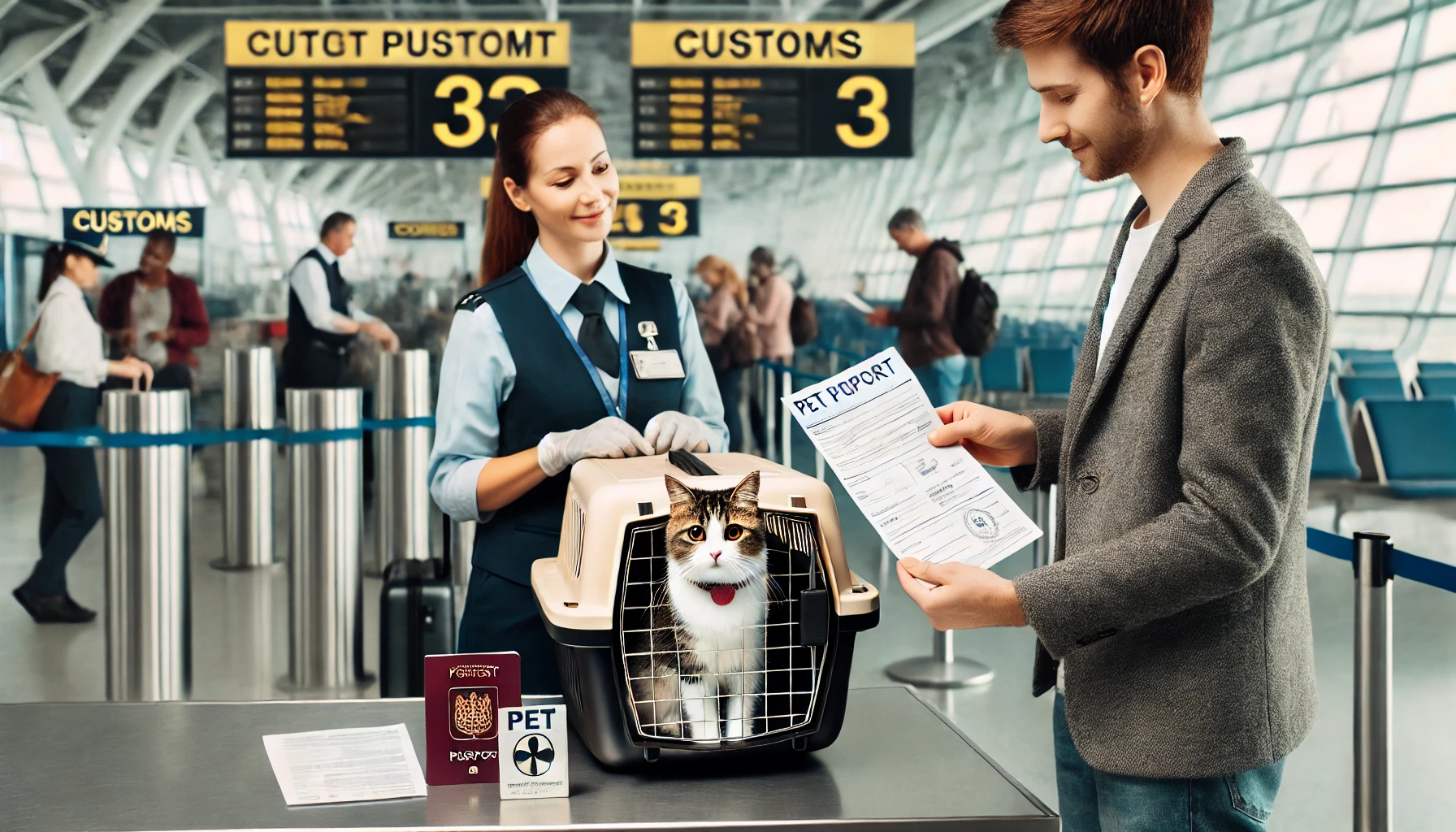
Conclusion on Handling Customs Regulations for Cats
In conclusion, adhering to customs regulations for cats is essential when traveling internationally.
You can make the process as painless as possible by preparing the required paperwork, minimizing the stress your cat may experience, and familiarizing yourself with the customs procedures of your destination country.
By following these guidelines, you’ll navigate the sometimes complex world of customs regulations with confidence, ensuring a safe and stress-free journey for your cat.
Understanding the necessary documentation and vaccination requirements is essential for ensuring smooth international travel with your cat.
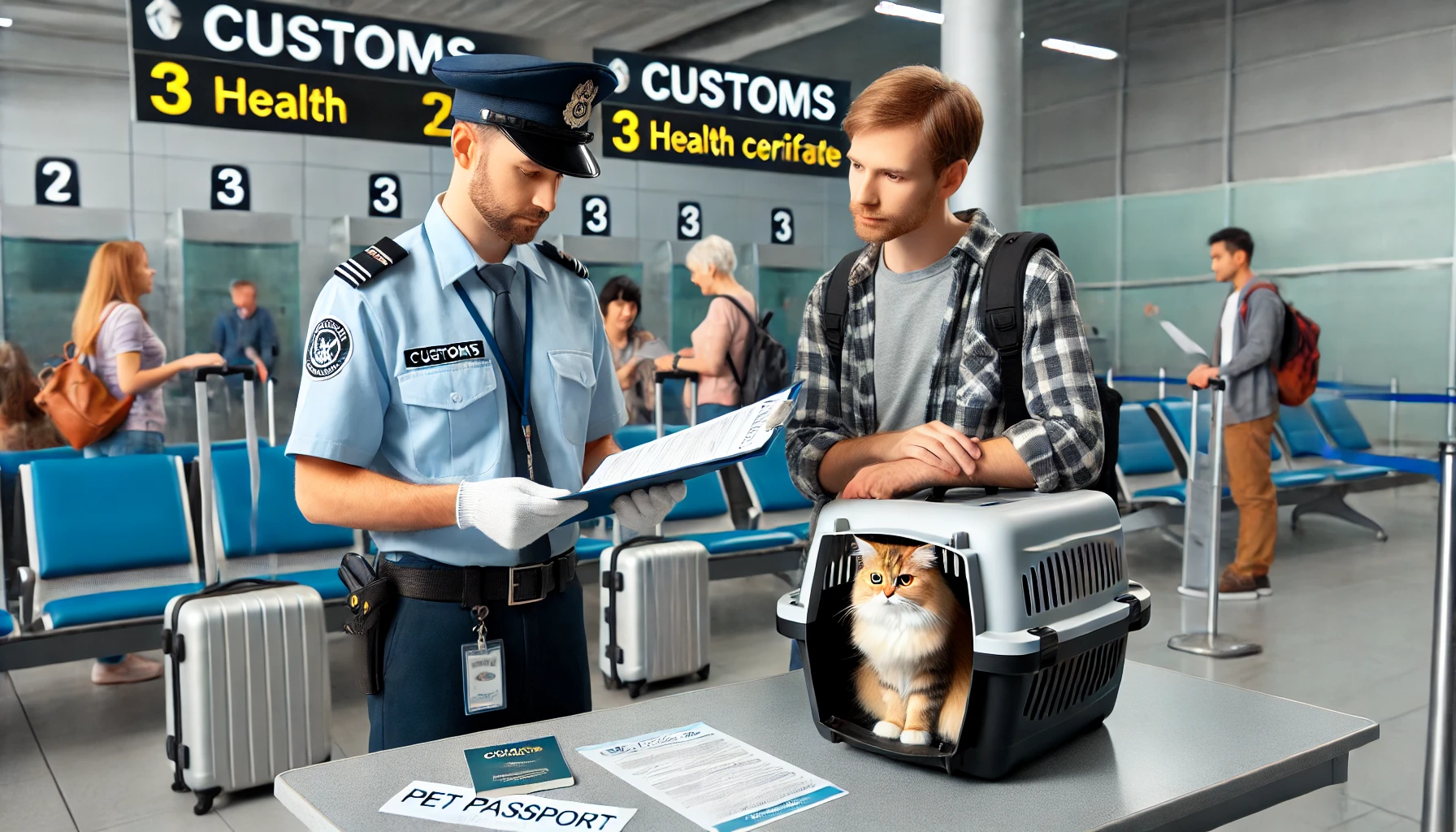
FAQs About Customs Regulations for Cats
When traveling internationally with your cat, there are several factors to consider.
Below are some of the most frequently asked questions about customs regulations and what you can do to prepare for a hassle-free experience for both you and your cat.
What documentation do I need to travel internationally with my cat?
You will need a valid pet passport or veterinary certificate, proof of current rabies vaccination, additional health certificates from a licensed veterinarian, and microchip identification, depending on your destination country’s customs regulations.
Does my cat need to be microchipped for international travel?
Yes, many countries require a microchip for identification.
It must be ISO-compliant and match the details in your cat’s documents to pass customs clearance.
Are there countries with quarantine requirements for cats?
Yes, certain countries, like Australia and Japan, require quarantine for cats.
The length and conditions of quarantine depend on the customs regulations of the destination country and your cat’s health status.
How can I help minimize my cat’s travel stress?
You can reduce your cat’s stress by using calming aids, getting them accustomed to their carrier, keeping them hydrated, and maintaining a quiet and calm environment on travel day.
What happens if my cat’s vaccinations are not up to date?
If your cat’s vaccinations, especially rabies, are not current, customs officials may deny entry or impose quarantine.
It’s essential to check and ensure all vaccinations meet the destination country’s customs regulations well in advance.

